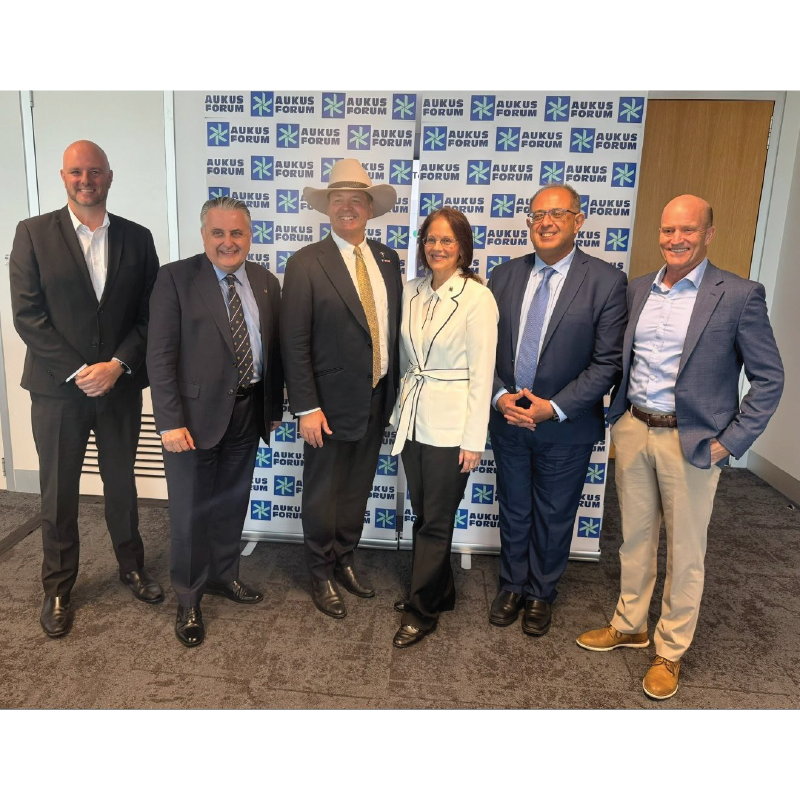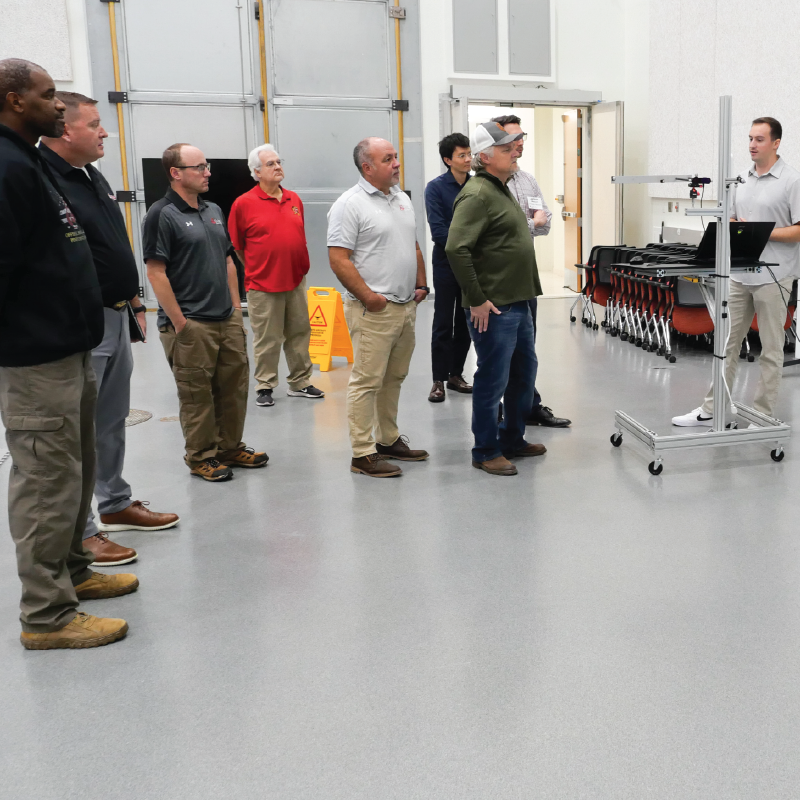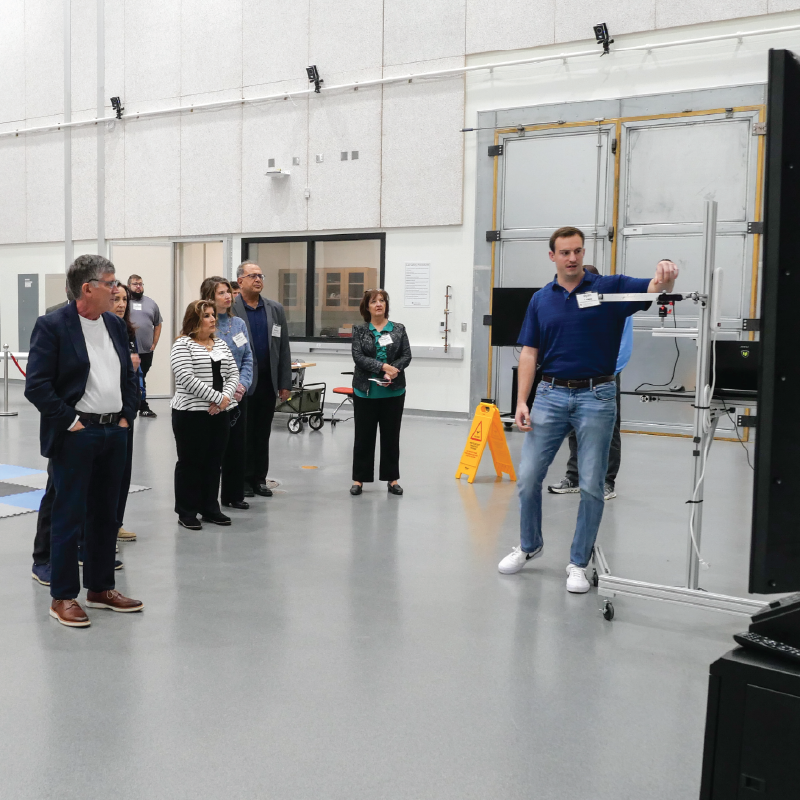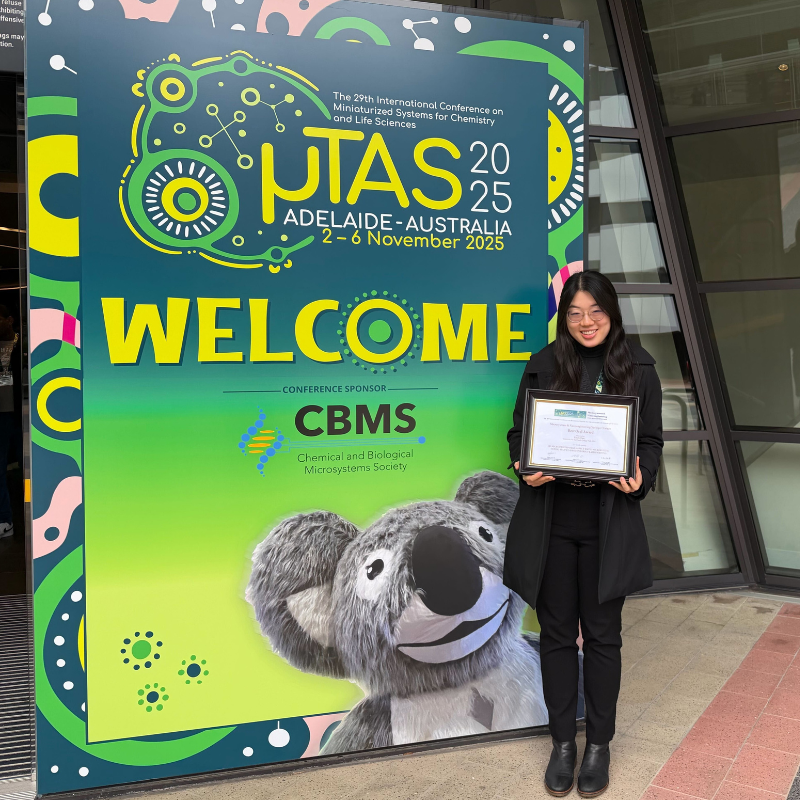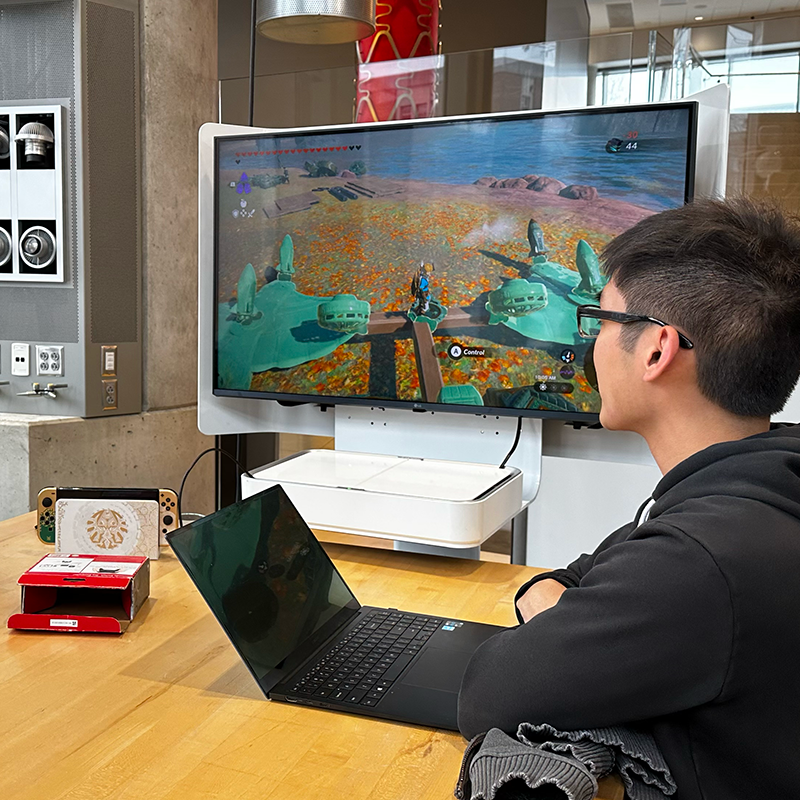News Story
Clark School Research Team Introduces World's First Invisibility Cloak
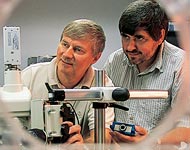
Prof. Christopher Davis (left) and Research Scientist Igor Smolyaninov
Attention, Harry Potter fans -- the be-spectacled teenage wizard's invisibility cloak may not be confined to the realm of fiction for much longer.
A University of Maryland research team comprised of Visiting Research Scientist Igor Smolyaninov, Professor of Electrical and Computer Engineering Christopher Davis, and graduate student Yu-Ju Hung, has created the world's first true invisibility cloak.
The new cloak is just 10 micrometers in diameter; by comparison, a human hair is between 50 to 100 micrometers wide. The cloak works by guiding rays of light around an object hidden inside and releasing the light rays on the other side. This causes the light waves to appear to have moved in a straight line, making the cloak and the object inside of it invisible.
The group's research currently utilizes a two-dimensional demonstration of the cloak over a limited wavelength range. Three-dimensional invisibility cloaks represent a more significant challenge, requiring researchers to control light waves both magnetically and electronically to steer them around the hidden object.
The research team, based in the University's A. James Clark School of Engineering, has made use of the unique properties of metamaterials, artificially structured substances that help control electromagnetic waves in unusual ways.
The cloak consists of a two-dimensional pattern of concentric gold rings coated in a plastic called polymethyl methacrylate. The plastic and the gold each have different refractive properties, and bend plasmons -- electron waves generated when light strikes a metallic surface -- in different directions. The whole arrangement lies flat on a gold surface. By varying the mix of metal and plastic in different areas of the cloak, the team can control and guide plasmons around the cloak, as water in a stream flows around a rock.
Media Coverage
The team's research has been covered by the media, including New Scientist, and a manuscript describing the research is available online at http://arxiv.org/abs/0709.2862. The research was also included in Discover Magazine's Top 100 science stories of 2007.
View a press release about this technology online.
Media Links:
Additional Links:
|
Clark School Researchers
Develop Two-Dimensional Invisibility Cloak Lab Business Week, January 6, 2008, EXPANDED REPORTING; Pg.
240, 841 words
|
|
|
|
Clark School Researchers
Develop Two-Dimensional Invisibility Cloak Pharma Investments, Ventures & Law Weekly, January 6,
2008, EXPANDED REPORTING; Pg. 846, 849 words
|
|
|
|
Clark School Researchers
Develop Two-Dimensional Invisibility Cloak Healthcare Mergers, Acquisitions & Ventures Week, January 5,
2008, EXPANDED REPORTING; Pg. 239, 852 words
|
|
|
|
Clark School Researchers
Develop Two-Dimensional Invisibility Cloak Law & Health Weekly, January 5, 2008, EXPANDED REPORTING; Pg.
380, 841 words
|
|
|
|
Clark School Researchers
Develop Two-Dimensional Invisibility Cloak Medical Imaging Week, January 5, 2008, EXPANDED REPORTING; Pg.
104, 842 words
|
|
|
|
Clark School Researchers
Develop Two-Dimensional Invisibility Cloak Obesity, Fitness & Wellness Week, January 5, 2008, EXPANDED
REPORTING; Pg. 2926, 846 words
|
|
|
|
Clark School Researchers
Develop Two-Dimensional Invisibility Cloak Telemedicine Law Weekly, January 5, 2008, EXPANDED REPORTING; Pg.
103, 842 words
|
|
|
|
Clark School Researchers
Develop Two-Dimensional Invisibility Cloak Biotech Law Weekly, January 4, 2008, EXPANDED REPORTING; Pg.
1308, 840 words
|
|
|
|
Clark School Researchers
Develop Two-Dimensional Invisibility Cloak Health Business Week, January 4, 2008, EXPANDED REPORTING; Pg.
225, 842 words
|
|
|
|
Clark School Researchers
Develop Two-Dimensional Invisibility Cloak Lab Law Weekly, January 4, 2008, EXPANDED REPORTING; Pg.
268, 839 words
|
|
|
|
Clark School Researchers
Develop Two-Dimensional Invisibility Cloak Medical Imaging Business Week, January 3, 2008, EXPANDED REPORTING;
Pg. 103, 845 words
|
|
|
|
A bubbly toast to researchers; Team
probes wave effect at College Park The Washington Times, January 3, 2008 Thursday, LIFE - SCIENCE
& TECHNOLOGY; B01, 940 words, By Shelley Widhalm, THE
|
|
|
|
Clark School Researchers
Develop Two-Dimensional Invisibility Cloak Biotech Week, January 2, 2008, EXPANDED REPORTING; Pg.
3941, 839 words
|
|
|
|
Clark School Researchers
Develop Two-Dimensional Invisibility Cloak Healthcare Finance, Tax & Law Weekly, January 2, 2008, EXPANDED
REPORTING; Pg. 369, 847 words
|
|
|
|
Clark School Researchers
Develop Two-Dimensional Invisibility Cloak Telemedicine Business Week, January 2, 2008, EXPANDED REPORTING;
Pg. 103, 844 words
|
|
|
|
Clark School Researchers
Develop Two-Dimensional Invisibility Cloak Life Science Weekly, January 1, 2008, EXPANDED REPORTING; Pg.
3991, 841 words
|
|
|
|
Clark School Researchers
Develop Two-Dimensional Invisibility Cloak Medical Imaging Law Weekly, January 1, 2008, EXPANDED REPORTING;
Pg. 103, 843 words
|
|
|
|
Clark School Researchers
Develop Two-Dimensional Invisibility Cloak Pharma Law Weekly, January 1, 2008, EXPANDED REPORTING; Pg.
874, 840 words
|
|
|
|
Clark School Researchers
Develop Two-Dimensional Invisibility Cloak Science Letter, January 1, 2008, EXPANDED REPORTING; Pg.
4049, 840 words
|
|
|
|
Clark School Researchers
Develop Two-Dimensional Invisibility Cloak Telemedicine Week, January 1, 2008, EXPANDED REPORTING; Pg.
103, 841 words
|
|
|
|
Clark School Researchers
Develop Two-Dimensional Invisibility Cloak Biotech Business Week, December 31, 2007, EXPANDED REPORTING; Pg.
1986, 842 words
|
|
|
|
Clark School Researchers
Develop Two-Dimensional Invisibility Cloak Health & Medicine Week, December 31, 2007, EXPANDED REPORTING;
Pg. 3182, 843 words
|
|
|
|
Clark School Researchers
Develop Two-Dimensional Invisibility Cloak Pharma Business Week, December 31, 2007, EXPANDED REPORTING; Pg.
2101, 842 words
|
Published December 18, 2007


